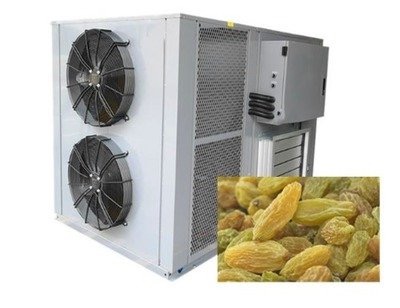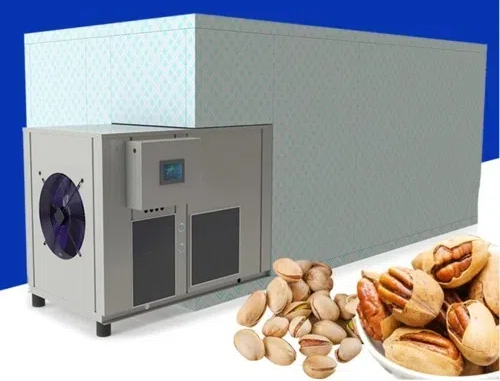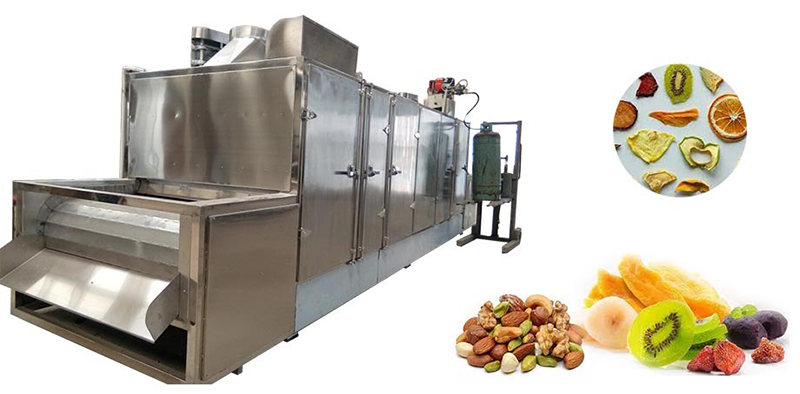
Content Menu
● Understanding Heat Pump Dryers
>> How Heat Pump Dryers Work
● Advantages of Heat Pump Dryers
● How to Empty the Water Tank in a Heat Pump Dryer
>> Step 1: Locate the Water Tank
>> Step 2: Remove the Water Tank
>> Step 3: Empty the Water Tank
>> Step 4: Clean the Tank (Optional)
>> Step 5: Reinsert the Water Tank
● Maintenance Tips for Heat Pump Dryers
● Food Drying Machines: An Overview
>> Benefits of Food Drying Machines
● Types of Food Drying Machines
● Choosing the Right Food Drying Machine
● Common Applications of Food Drying Machines
● Conclusion
● FAQ
>> 1. How often should I empty my heat pump dryer's water tank?
>> 2. Can I use my heat pump dryer without emptying the water tank?
>> 3. What happens if I forget to empty the water tank?
>> 4. Are heat pump dryers noisy?
>> 5. How long do heat pump dryers typically last?
Heat pump dryers have become increasingly popular due to their energy efficiency and ability to dry clothes without excessive heat. However, many users often wonder how to properly empty the water tank in a heat pump dryer. This article will explore the workings of heat pump dryers, their advantages, and provide a detailed guide on emptying the water tank. Additionally, we will delve into the world of food drying machines, particularly focusing on how they can benefit businesses in the food industry.

Understanding Heat Pump Dryers
Heat pump dryers are a type of condenser dryer that uses a heat pump to recycle air and moisture during the drying process. Unlike traditional dryers that expel hot air outside, heat pump dryers use a closed-loop system to extract moisture from clothes and condense it into water, which is then collected in a tank.
How Heat Pump Dryers Work
1. Air Circulation: The dryer draws in air from the surrounding environment.
2. Heating: The air is heated using a refrigerant system.
3. Moisture Extraction: The warm air is circulated through the wet clothes, absorbing moisture.
4. Condensation: The moist air is passed through a heat exchanger where it cools down, causing the moisture to condense into water.
5. Water Collection: The condensed water is collected in a tank for later disposal.
Advantages of Heat Pump Dryers
- Energy Efficiency: Heat pump dryers use significantly less energy compared to traditional dryers. They can save up to 50% more energy than conventional vented dryers.
- Gentle Drying: They operate at lower temperatures, which helps protect delicate fabrics from damage and shrinkage.
- Versatile: Suitable for various types of fabrics and can be used year-round, making them ideal for all seasons.
- Environmentally Friendly: By consuming less energy, heat pump dryers contribute to lower carbon emissions.
- Convenience: Many models come with built-in sensors that detect moisture levels and automatically adjust drying time, preventing over-drying.
How to Empty the Water Tank in a Heat Pump Dryer
Emptying the water tank in a heat pump dryer is crucial for maintaining optimal performance. Here's a step-by-step guide:
Step 1: Locate the Water Tank
Most heat pump dryers have a transparent or semi-transparent water tank located at the front or top of the machine. This design allows users to easily monitor water levels.
Step 2: Remove the Water Tank
Gently pull out the water tank from its compartment. Be careful not to spill any water during this process. Some models may have a release button or latch that needs to be pressed before removal.
Step 3: Empty the Water Tank
Take the tank to a sink or drain and pour out the collected water. It is advisable to do this slowly to avoid splashing.
Step 4: Clean the Tank (Optional)
It's advisable to rinse the tank with warm water occasionally to prevent any buildup of residue or mold. This is especially important if you notice any unpleasant odors coming from the tank.
Step 5: Reinsert the Water Tank
Once emptied and cleaned, carefully place the water tank back into its compartment until it clicks into place, ensuring it is securely fitted.

Maintenance Tips for Heat Pump Dryers
To ensure your heat pump dryer operates efficiently, follow these maintenance tips:
- Regular Cleaning: Clean the lint filter after each use and check for blockages in the venting system. A clogged lint filter can significantly reduce efficiency.
- Check Seals: Inspect door seals for wear and tear; replace them if necessary to prevent leaks and maintain energy efficiency.
- Service Regularly: Schedule professional servicing at least once a year. This can help identify potential issues before they become major problems.
- Keep Surrounding Area Clear: Ensure there is adequate space around your dryer for ventilation. Poor airflow can affect performance.
- Monitor Performance: Pay attention to how well your dryer is performing; if you notice longer drying times or unusual noises, it may be time for maintenance.
Food Drying Machines: An Overview
Food drying machines are essential tools for preserving food by removing moisture content. These machines come in various forms, including dehydrators and industrial food drying machines.
Benefits of Food Drying Machines
- Preservation: Extends shelf life by inhibiting microbial growth while retaining flavor and nutrients.
- Nutrient Retention: Maintains vitamins and minerals better than other preservation methods such as freezing or canning.
- Versatility: Can dry fruits, vegetables, meats, herbs, and even flowers for decorative purposes.
- Cost-effective: Reduces food waste by allowing you to preserve excess produce at home or in commercial settings.
- Healthier Snacking Options: Dried fruits and vegetables make for nutritious snacks without added preservatives or sugars found in many store-bought options.
Types of Food Drying Machines
1. Dehydrators: Ideal for home use; they are compact and easy to operate with adjustable temperature settings suitable for different types of food.
2. Industrial Dryers: Used by manufacturers; they offer larger capacities and advanced features such as programmable settings and automated processes for bulk drying operations.
3. Solar Food Dryers: Utilize solar energy for drying foods; they are eco-friendly but depend on weather conditions for efficiency.
4. Microwave Food Dryers: Use microwave radiation combined with airflow to quickly remove moisture from foods; suitable for small batches but may require careful monitoring to avoid overheating.
Choosing the Right Food Drying Machine
When selecting a food drying machine, consider factors such as:
- Capacity: Choose based on your production needs; larger families or businesses may require machines with higher capacities.
- Temperature Control: Look for models with adjustable temperature settings; different foods require different temperatures for optimal drying.
- Energy Efficiency: Opt for energy-efficient models to save on electricity costs while minimizing environmental impact.
- Ease of Use: Consider user-friendly designs that simplify operation and cleaning processes; digital controls can enhance convenience.
- Durability: Invest in high-quality materials that ensure longevity, especially if you plan on using it frequently or for commercial purposes.
Common Applications of Food Drying Machines
Food drying machines are widely used across various sectors:
- Home Kitchens: Individuals use dehydrators to make healthy snacks like dried fruits or jerky at home.
- Restaurants & Cafés: Chefs dry herbs and vegetables to create unique flavors in dishes without relying on preservatives.
- Food Manufacturers: Large-scale operations use industrial dryers to produce dried fruits, vegetables, and snacks efficiently.
- Emergency Preparedness: Many people dehydrate foods as part of their emergency preparedness plans due to their long shelf life.
Conclusion
Heat pump dryers offer an energy-efficient way to dry clothes while maintaining fabric integrity. Understanding how to empty the water tank is essential for optimal performance. Similarly, food drying machines play a crucial role in food preservation, offering various benefits for both home users and businesses.
By investing in quality drying equipment—whether it's a heat pump dryer for your laundry needs or a food drying machine for preserving food—you can enhance your daily routines while contributing positively towards sustainability efforts.

FAQ
1. How often should I empty my heat pump dryer's water tank?
You should empty the water tank after every drying cycle or as needed based on usage patterns observed during operation.
2. Can I use my heat pump dryer without emptying the water tank?
No, using it without emptying can lead to reduced efficiency as well as potential damage due to overflow issues within the machine itself.
3. What happens if I forget to empty the water tank?
If you forget to empty it regularly, your dryer may stop working effectively since it cannot collect more moisture once full; this could also trigger error codes on some models indicating maintenance is required.
4. Are heat pump dryers noisy?
Heat pump dryers are generally quieter than traditional dryers due primarily due their design which minimizes vibrations during operation; however some noise may still occur depending on model specifications and load sizes being dried simultaneously.
5. How long do heat pump dryers typically last?
With proper maintenance practices followed diligently over time (such as regular cleaning), heat pump dryers can last between 10–15 years before requiring replacement parts or complete unit replacement altogether due wear-and-tear accumulated throughout usage cycles over years spent operating continuously under varying conditions encountered during normal daily tasks performed routinely by users themselves!












